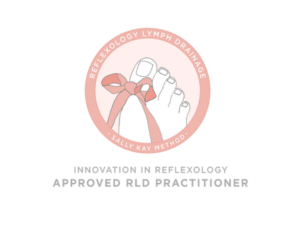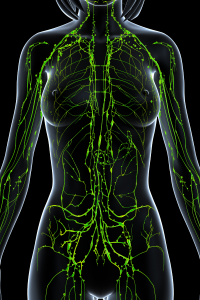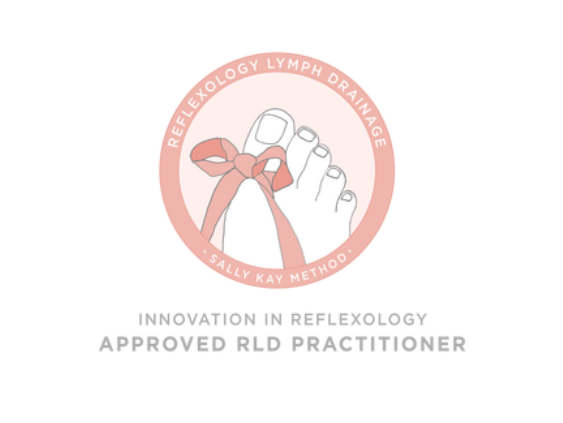
I am delighted to have become an approved Reflexology Lymph Drainage (RLD) Practitioner and to be able to offer this award-winning, evidence-based, reflexology technique that focuses on stimulating the lymphatic reflexes on the feet. The aim is to cause an effect on the lymphatic system in the body. It is a unique sequence that was researched and developed by UK reflexologist Sally Kay BSc (Hons), whilst working in Cancer Care.
Working as part of a team of therapists at a hospice, Sally Kay observed the positive effect that Manual Lymph Drainage massage (MLD) had in reducing the symptoms of secondary lymphoedema in cancer patients and as a result developed the RLD technique based on the anatomy, physiology and function of the lymphatic system, and the principles of MLD massage and Simple Lymph Drainage exercises (SLD). RLD uses the theory of reflexology – that all the systems and organs of the body are reflected in the feet – to mirror these principles on the corresponding reflexes of the feet.
Manual Lymphatic Drainage massage (MLD) is a very gentle, light touch massage technique that aims to promote movement of excess lymph and fluid out of the tissues and back into the lymphatic vessels.
Simple Lymph Drainage (SLD) is a self-help, lymph drainage massage type of exercise that can be done by the individual. In principle, it is a simple basic version of MLD.

WHAT IS THE LYMPHATIC SYSTEM?
The lymphatic system forms an important part of your immune system, producing the cells required to defend the body from foreign bacteria and viruses. It also acts as a waste disposal system, removing excess fluid and cellular waste from the body’s tissues, known as ‘lymph’, and moving it via a network of vessels to lymph nodes found in the neck, armpits and groin where it is cleansed and drained back into the circulation system for eventual elimination from the body.
The lymphatic system is a one-way drainage system. Unlike blood circulation, which is a two-way transport system that is pumped by the heart, lymph relies on movement, breathing and gravity to transport it in one direction. Lymph is moved around the body by the massaging effect of the surrounding muscles which forces the lymph forward.
WHAT IS LYMPHOEDEMA?
According to The Lymphoedema Support Network and NHS websites, lymphoedema is a swelling that develops because of an impaired lymphatic system. It can affect any part of the body but is most often seen in an arm or a leg.
Lymphoedema can be described as primary or secondary.
Primary lymphoedema is usually present from birth and is often caused by the underdevelopment of the lymphatic system. Recent research suggests that 6 in every 1000 people in the UK may be affected.
Secondary lymphoedema is the result of the lymphatic system not working properly often through damage or trauma. Examples of secondary lymphoedema are:
- surgery – particularly the removal of lymph nodes during cancer treatment
- scar tissue from radiotherapy can interrupt the normal flow of lymph
- cancer itself can result in a blockage in the lymphatic system
- accidental trauma/ injury or infection causing damage to the lymph vessels
- reduced mobility/ paralysis – muscle contraction is important for lymph movement
- veins not working properly
- obesity
To find out more Lymphoedema Support Network is a registered charity supporting those living with and affected by lymphoedema.
SYMPTOMS OF LYMPHOEDEMA
Initially, swelling may fluctuate. It could be minimal on waking but becoming noticeably worse as the day goes on, especially in warm weather. However, if left untreated, over time the swelling can become increasingly hard and solid and more permanent; it doesn’t subside overnight.
Other symptoms include:
- clothing and jewellery feel tight
- an aching, heavy feeling in the limbs
- difficultly with movement
- distorted limb shape
- hard, tight skin
- repeated skin infections
- folds developing in the skin
- wart-like growths developing on the skin
- fluid leaking through the skin
- loss of confidence and altered body image
- inability to complete everyday tasks, employment, and leisure activities
According to Cancer Research (UK 2011), breast cancer is the most common cancer in the UK and the lifetime risk of developing it is 1: 8 for women and 1:1014 for men. Approximately 20% of patients develop secondary lymphoedema of the arm following treatment for breast cancer. Research suggests that survivors with lymphoedema are more likely to suffer psychological and emotional difficulties, be more disabled, and experience a poorer quality of life than survivors without the condition. Improved breast cancer survival rates suggest that approximately 2:3 women survive the disease beyond 20 years. This means that more people are living longer with this debilitating side effect for which there is currently no cure.
In the same way that MLD is used to treat conditions other than lymphoedema, RLD can be used similarly and may be helpful in the management of autoimmune disorders, arthritis, asthma, eczema, chronic fatigue, fibromyalgia, ME, migraines and headaches, premenstrual syndrome, and sinus problems.
To find out more about RLD please watch this video testimonial and have a look at these photos to see the results that are possible
Photographic evidence of Reflexology Lymph Drainage – REFLEXOLOGY LYMPH DRAINAGE
WHAT HAPPENS DURING A SESSION?
RLD is a non-invasive treatment. Only your shoes and socks are removed. If you wish to see measurable results, I can measure your affected, swollen limb before and after treatment with a tape measure and record the volume of fluid using a limb volume circumference measurement system. I can also take optional photographs of the area before and after treatment. However, these measures aren’t essential to the treatment and many people are happy to feel and see the results in their bodies for themselves – maybe their shoes and socks are not so tight or they can wear a watch again without discomfort.
HOW MANY TREATMENTS ARE REQUIRED?
RLD can be used as a standalone treatment protocol or incorporated into regular reflexology sessions.
I would suggest an initial 4-week schedule of treatments is planned. Follow-up sessions can then be arranged as and when required. Some clients have monthly maintenance treatments and others prefer to have one-off sessions when they feel they need them. It is entirely up to the individual and a treatment plan will be personalised for you and your circumstances.
As with all reflexology treatments I provide, a consultation will take place prior to your first treatment where we will discuss your medical history and general health to allow me to ensure that reflexology treatment is suitable for you and to understand what your expectations are from your treatment.
To find out how RLD can help you, please contact me. I’m always more than happy to talk through any questions or concerns you may have.
References:
Reflexology Lymph Drainage – Sally Kay
Sally Kay’s RLD website: www.reflexologylymphdrainage.co.uk
The Lymphoedema Support Network website: www.lymphoedema.org.uk
NHS website: www.nhs.org
NB: Reflexologists do not diagnose, cure or treat specific conditions. Reflexology is not a substitute for medical treatment. Always consult a GP or other health professional for medical attention and advice.
